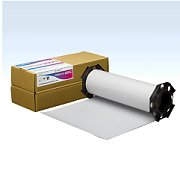 |
Product
Archive
|
|
| Visit
Spare home..
E-Mail: sales@spare.it |
 |
 |
Product
Archive
|
|
| Visit
Spare home..
E-Mail: sales@spare.it |
 |
Introduction: Thermoscale Film is a revolutionary new film that enables anyone to measure heat distribution easely by observing the variation in density and hue, that for instanxce, can be of great help to you in the operation of your heat sealing and processing equipment. Thermscale could be useful indeed for any further application where a thermal imaging, assumed as a "topographical map" (temperature imaging, in terms of local temperature distribution revealed), is required. It is economical, so that it can be used on a routine basis to reduce your packaging waste and improve your package quality. The paper is used to check the sealing heads of your packaging equipment so that you may determine if there is even die pressure and sufficient heat for consistent seals. This can be accomplished without breaking the web and interrupting production, and with a minimum loss of time and material. The paper produces a sharp, visual, permanent picture of the seal being produced, under production conditions. Thermscale paper is quite sensitive. It will not respond unless there is sufficient heat, but then the response is very fast (less than 0.1 second) and the picture of the seal is very crisp and sharp. The impression as per above figure on the top shows how the paper responds to the perforated sole plate of a very familiar steam iron. The white spots are the steam holes where there was no pressure applied to the paper. Note the sharp edges of the holes. A cut or nick in a sealing die will show up in the same manner, and if a sealing die is misaligned, the area of lesser pressure will not be as dark as the rest of the impression. You know where, and how well the die is sealing by the picture offered by Thermscale paper. If sealing, drying, odour, or adhesion troubles develop, the paper is invaluable. The operator can determine immediately if the heat-pressure requirements of the operation are adequate without shutting down the machine for a pyrometer check. He can determine if it is the packaging material or the machine that is at fault. If it is the sealing head that is at fault, the paper can be used to check the effect of the corrective adjustments as they are made. The paper provides a check on the entire seal area while a pyrometer checks only the temperature of the spot where it is placed. Having a pack of paper at each station where it is to be used will produce the greatest saving in time and machine waste. To be used most efficiently, it must be readily available. Product Development people and Trouble Shooters can carry the paper with them. Leaving some paper with a customer may save a trouble call by permitting the customer to determine for himself if it is the sealing head or the packaging material that is producing poor seals. The use of the Thermscale paper is very simple and intuitive and it will not require any specific user training, as since the first composed blue's colour levels impressed figure, it will offer an immediate visual tool of temperature distribution. If you also need to get a true pressure distribution imaging, do not forget to visit also Fuji Prescale film information pages. Thermscale main relevant features: - true visual "imaging" of temperature distribution and magnitudo; - "on line" tests are possible, without shut down production line; - very cheap and easy to use. Prescale film method of use: Thermscale paper turns a light blue colour at the low end of the temperature range and develops the maximum blue colour density at the high end of the temperature range. Thermscale available range and format: Thermscale paper is available in a single format; 32.0 x 52.0 cm (*). Larger areas are easily covered by overlapping the paper. Smaller areas could be accommodated simply by a scissor. Each standard pack have 25 sheets. Thermscale has a temperature response of 93 ºC to 149 ºC (200 ºF to 300 ºF). For lower temperature applications, a non standard Thermscale paper version (only with smallest size format) is available, with temperature range from 71 ºC to 105 ºC (160 ºF to 220 ºF). Contact us for any further detail. (*) If you are interested in larger sizes or rolls, call or write with your specific requirements. NOTE: Prices on present page header are for each pack, not including trasportation charges to your site (FOB our site in Italy). PDF format Thermscale support literature (Acrobat Reader is required) Typical applications: Thermscale paper has been successfully used in a very broad range of applications. Due to its very innovative and powerful temperature distribution revealing method (temperature imaging), its whole range of possible applications has not yet been ensured, since every day new applications are met. In any case, main applications are obviously related to thermal sealing process as also for packaging (e.g. blister, etc.). Generally speaking, Thermscale could be very useful indeed where any thermal process performed over any contact surface, have to be monitored about its correct distribution. |